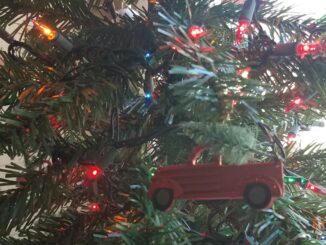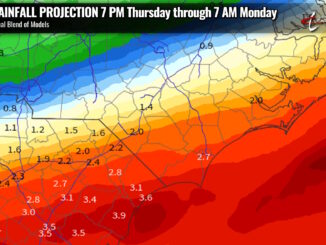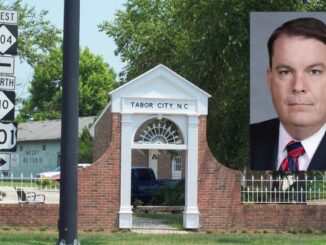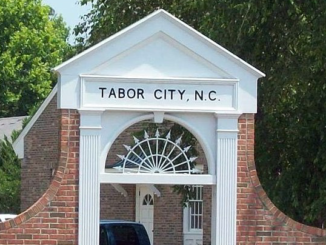
It sits waiting for its final end, as it has for decades.
One day, one of the tired old oaks or the upstart pines in the yard will crash down, taking another piece of the old house and maybe bringing about an ignominious end. Even I must admit, however begrudgingly, that it is already beyond salvation. The windows are long since broken, frames hanging precariously. Holes in the shingle roof allow rain as well as a sunshine inside.
Out of respect for the posted signs, gate and fence, I’ve never done more than pull in on the road beside the old house, but when the briars and bushes are down for the winter, you can see hints of pale blue painted plaster dripping from the walls in one room, a darker color falling like crumbling tears from another.
The house was once a riot of glorious Victorian excess; gingerbread trim framed the three-sided porch and eaves. Although the woodwork is rotten, you can see how the sidelights and overhead window once framed an enormous door, likely of oak, wide enough for a hoop skirt to pass through or a coffin to be carried.
Two enormous bay windows once gave view to a yard that was just far enough off the then-sandy road for safety, but close enough to see what was happening in the world.
I am told there’s a walkway buried beneath the old grass and pine straw where in the spring, jonquils stubbornly stand proud covering the flanks of roses long since gone rank. The gardenias and camellias still bloom in season, as do a couple of gnarled dogwoods.
It’s frustrating in some ways that I have been able to find out bits and pieces about the place, but its full history remains somewhat lost to the casual detective with a love of architecture. Whether the remaining memories of peeling white paint were the original color or not I have no idea — I doubt it, since so many homes of that era were often anything but white, except for folks barely above the level of working poor.
White walls became as ubiquitous as lead-filled brown or gray floor paint of the second quarter of the 20th century, covering the glorious wealth of dark pine or cypress, boards sometimes wider than a man’s forearm is long, other times locked tightly in tongue and groove milling carefully hewn by a snorting steam sawmill. It breaks my heart to see such heresy, and it has broken my back removing those heavy paints to bring an old floor back to life, but I am not one to judge previous generations by modern standards, whether it’s something “enlightened” generations consider a sociopolitical horror or just a travesty others found to be a practical upgrade to a building.
Once upon a time, nails were made by hand. Until the late 19th century, and for sometime thereafter, nails were made by hand, a rod heated, drawn out on anvil, tapered in a “swage”, then snapped off, hundreds of times. I’ve made nails in a forge; you learn to appreciate the good true swing of a hammer. Now a bent nail is cast aside and forgotten.
We now live in a time of plywood and chemically-treated lumber and two-by-four planks that are actually more like 1.75 by 3.65, where pieces are forced together with a pneumatic nail-gun and practical sheetrock covers the walls, followed by layers of plywood topped with cushions and carpet or, ironically, vinyl designed to look like wood.
I grew up in houses with interior walls made of real pine boards, 3/8 inch thick and cut on an angle, not the rectangles of laminate stuff. I’ve lived in others where the walls were made of individual lathes, each one tacked precisely in place on a heart-pine stud, then coated with plaster that was mixed by hand, sometimes thickened with hair, then smoothed and painted. Insulation, if it existed, would horrify most modern building inspectors: junk cotton, sawdust, and in some cases, newspapers.
I once found a treasure trove of newspapers, the newest from the 1970s and the oldest from the 40s, that an elderly lady was storing to eventually insulate her farmhouse. Her children, who were amused that anyone would want to explore the old place, said she saved everything, and even tacking newspapers up as wallpaper as she had done during the Depression.
There’s a development on that farm now, a dozen or so modular homes where new families never have to split a chunk of wood to be warm or cook a meal, the water comes from sanitary pipes fed by a county-operated system, and the kids ride in climate-controlled comfort on the way to school, rather than trudging a couple miles down a shell road. I am sure there’s not a single newspaper jammed into a gap in a single wall, even if there are gaps in said walls. In all honesty, I’m happy for the folks who live there, who have made their homes on what was once a farm of tobacco and hogs and a garden pecked clean by chickens.
I am sure that someday, the sad old home I glance at every week will be replaced by a mobile home, or maybe just become a pile of scrap wood to be burned by a vandal or an industrious farmer. The rafters (already visible in some places, embarrassing as a glimpse of a petticoat would have been when the house was new) will sigh and crumble, allowing the peaks and dormers to crash to the earth. Indeed, a chinaberry tree has already claimed the kitchen and its dogtrot that was turned into an enclosed porch. Given enough time, one could probably find a ghost of the other buildings that made the house a home — a smokehouse, perhaps, or a chicken coop. Maybe a barn. Perhaps there’s even a privy turned trash dump when a Delco unit or the rural electric association made indoor plumbing possible.
If it’s just ignored, the house will just fall, the pines will eventually beat out the oaks, and the brambles will cover everything, leaving what was once a showplace, then a rental, then a tenant house to be little more than a haunt for possums, foxes and the occasional feral cat. It ain’t much more than a pile of wood held together by rusted nails and grapevines right now.
I would have loved to have seen it when horses were tied to a rail around the yard, and lights blazed in the big bay windows. I like to think of the fancy little house beside the road as a happy home, where friends and family spent time on the front porch, where youngsters romanced on the side porches, and old men told tales of The War and argued politics, where a perpetually harassed lady of the house held sway over everything and everyone.
Instead, the old showplace is now just a shadow to be ignored by most who pass this way, folks intent on a short cut determined by GPS, or truck drivers delivering hogs or grain, and farmers who no longer see the old house, which has been abandoned since they were children.
Perhaps someone will scavenge a window frame, a door, or even a mantle or staircase from the remains. A bottle collector will hunt for old trash piles. Maybe a treasure hunter with a metal detector will spend a Sunday sorting through old iron and tin to find a coin, a spoon, a hand-forged nail, or even a ring, reminders of a time when the lights were bright and the house was a happy home.


























